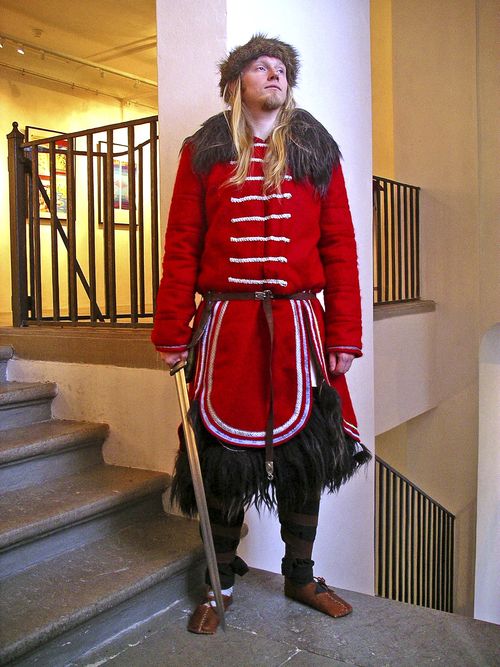Humans First Wore Clothing 170,000 Years Ago
http://news.discovery.com/human/humans-first-wore-clothing-170000-years-ago.html
By Jennifer Viegas | Thu Jan 6, 2011 01:35 PM ET
Humans began to wear clothing 170,000 years ago, concludes a new study that suggests our ancestors first put on clothes after the second-to-last Ice Age, when being nude must have been too cool for comfort.
The evidence comes from seemingly very unfashionable lice, since scientists tracked when head lice evolved into clothing/body lice around 170,000 years ago. So lice have been with us since the world’s first clothes were made.

(Viking attire circa 900 A.D. By this advanced stage, humans had created very sophisticated and colorful ways to clothe themselves. Credit: Annika Larsson)
The study, published in this month’s Molecular Biology and Evolution journal, explains how DNA sequencing of the parasites was used to calculate when clothing lice first began to genetically diverge from human head lice.

(Adult female, left, and adult male, right, head lice; Wikimedia Commons image)
“We wanted to find another method for pinpointing when humans might have first started wearing clothing,” said project leader David Reed, associate curator of mammals at the Florida Museum of Natural History, in a University of Florida press release. “Because they are so well adapted to clothing, we know that body lice or clothing lice almost certainly didn’t exist until clothing came about in humans.”
The findings reveal that our ancestors started to wear clothing long after they lost their ape-like body hair. Genetic skin coloration research shows that hair loss happened around one million years ago, long before modern humans emerged in Africa. Our ancestors were likely running around nude and relatively hairless for quite some time then.
“It’s interesting to think humans were able to survive in Africa for hundreds of thousands of years without clothing and without body hair, and that it wasn’t until they had clothing that modern humans were then moving out of Africa into other parts of the world,” Reed said.
He added that our success and progression as a species has been made possible, in large part, to our “controlled use of fire, the ability to use clothing, new hunting strategies and new stone tools.”
Since our ancestors are thought to have migrated out of Africa and into colder climates and higher latitudes anywhere from 100,000 to 60,000 years ago, the findings indicate the invention of clothing made such long journeys northward possible.
The second to the last Ice Age occurred around 180,000 years ago, so in the aftermath of that cooling, humans may have figured out that putting on clothes- probably animal furs and skins- had enormous benefits. Years ago I also read some interesting studies on how a drive to express individuality and status pushed humans to wear more distinctive clothing, shoes and jewelry, and to don makeup and sport tattoos. Group divisions and competition can fuel that “look at me” desire, along with needing to visually affiliate oneself with a particular sect.
A study of clothing lice in 2003 led by Mark Stoneking, a geneticist at the Max Planck Institute in Leipzig, Germany, estimated humans first began wearing clothes about 107,000 years ago. But the UF research includes new data and calculation methods.
“The new result from this lice study is an unexpectedly early date for clothing, much older than the earliest solid archaeological evidence, but it makes sense,” said Ian Gilligan, lecturer in the School of Archaeology and Anthropology at The Australian National University. “It means modern humans probably started wearing clothes on a regular basis to keep warm when they were first exposed to Ice Age conditions.”
Lice aren’t exactly beloved creatures. They’re usually associated with miserable kids having to go through lice removal treatments. From a scientific standpoint, however, they are valuable. These parasites are often found stranded on lineages of hosts over long periods of time, permitting researchers to learn about evolutionary changes in the host based on changes in the parasite.
Lice don’t just tell us about clothing either. Such research on them, according to Reed, “gives the opportunity to study host-switching and invading new hosts — behaviors seen in emerging infectious diseases that affect humans.”